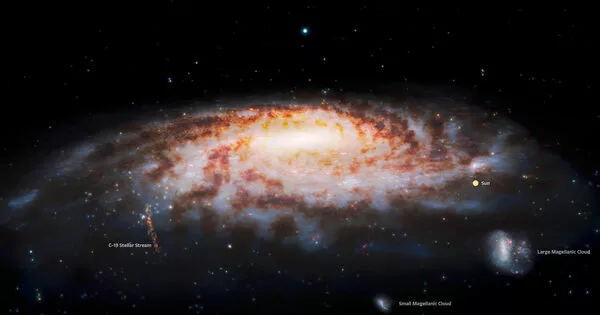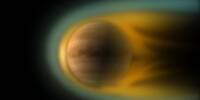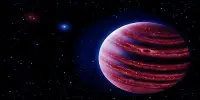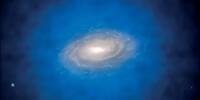If there were to be footprints of galactic immigration uncovered in the Andromeda galaxy, this would be a significant discovery in the field of astronomy and astrophysics. The Andromeda galaxy, also known as M31, is the closest spiral galaxy to our Milky Way, located about 2.5 million light-years away.
One way that scientists might be able to detect evidence of galactic immigration is by studying the distribution and properties of stars within the Andromeda galaxy. If a significant number of stars within the galaxy have different chemical compositions and properties than the native stars, this could suggest that they were formed elsewhere and later migrated to the Andromeda galaxy.
Astronomers have discovered compelling new evidence for a massive star migration into the Andromeda Galaxy. Star motion patterns reveal an immigration history very similar to that of the Milky Way.
Over billions of years, galaxies grow and evolve by producing new stars and merging with other galaxies in what are known as “galactic immigration” events. Astronomers study the motions of individual stars in a galaxy and its extended halo of stars and dark matter to try to uncover the histories of these immigration events. Until now, however, such cosmic archaeology was only possible in our own galaxy, the Milky Way.
Our new observations of the Milky Way’s nearest large galactic neighbor, the Andromeda Galaxy, reveal evidence of a galactic immigration event in exquisite detail.
Arjun Dey
An international research team has discovered compelling new evidence of a large galactic immigration event in the Andromeda Galaxy, the Milky Way’s nearest large galactic neighbor. The new findings were obtained using the DOE’s Dark Energy Spectroscopic Instrument (DESI) on the Nicholas U. Mayall 4-meter Telescope at Kitt Peak National Observatory, which is part of the National Science Foundation’s NOIRLab Program.
The team discovered telltale patterns in the positions and motions of nearly 7500 stars in the inner halo of the Andromeda Galaxy, also known as Messier 31 (M31), by measuring their motions. These patterns revealed how these stars began their lives as part of another galaxy that merged with M31 about 2 billion years ago. While such patterns have long been predicted by theory, they have never been seen with such clarity in any galaxy.
“Our new observations of the Milky Way’s nearest large galactic neighbor, the Andromeda Galaxy, reveal evidence of a galactic immigration event in exquisite detail,” explained Arjun Dey, astronomer at NSF’s NOIRLab and the lead author of the paper presenting this research. “Although the night sky may seem unchanging, the Universe is a dynamic place. Galaxies like M31 and our Milky Way are constructed from the building blocks of many smaller galaxies over cosmic history.”
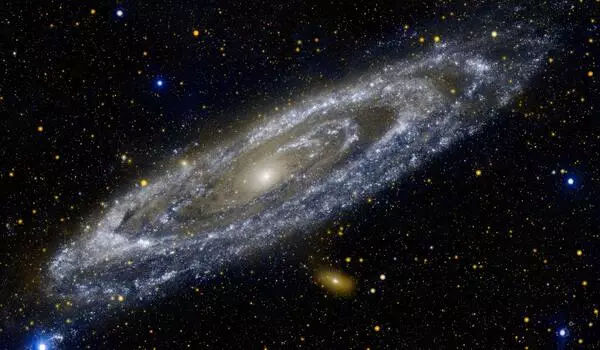
“We have never seen this so clearly in the motions of stars, nor have we seen some of the structures that result from this merger,” said Sergey Koposov, an astrophysicist at the University of Edinburgh and coauthor of the paper. “The emerging picture is that the history of the Andromeda Galaxy is similar to that of our own Galaxy, the Milky Way. The inner halos of both galaxies are dominated by a single immigration event.”
This research sheds light not only on the history of our galactic neighbors, but also on the history of our own galaxy. The majority of the stars in the Milky Way’s halo formed in another galaxy and later migrated into ours during a galactic merger 8-10 billion years ago. Studying the relics of a similar, but more recent, galaxy merger in M31 gives astronomers a window onto one of the major events in the Milky Way’s past.
To trace the history of migration in M31, the team turned to DESI. DESI was constructed to map tens of millions of galaxies and quasars in the nearby Universe in order to measure the effect of dark energy on the expansion of the Universe. It is the most powerful multi-object survey spectrograph in the world, and is capable of measuring the spectra of more than 100,000 galaxies a night. DESI’s world-class capabilities can also be put to use closer to home, however, and the instrument was crucial to the team’s survey of M31.
“This science could not have been accomplished at any other facility on the planet. The incredible efficiency, throughput, and field of view of DESI make it the best system in the world for surveying the stars in the Andromeda Galaxy “Dey stated. “DESI was able to surpass more than a decade of spectroscopy with much larger telescopes in only a few hours of observing time.”
Despite the fact that the Mayall Telescope was completed 50 years ago (first light in 1973), it remains a world-class astronomical facility due to ongoing upgrades and cutting-edge instrumentation. “Fifty years sounds like a long time, and one might mistakenly believe that’s the natural lifetime of a facility,” said NOIRLab co-author Joan R. Najita. “But with renewal and reuse, a venerable telescope like the Mayall can continue to make amazing discoveries despite being relatively small by today’s standards.”
The research was carried out in collaboration with two Harvard University undergraduates, Gabriel Maxemin and Joshua Josephy-Zack, who connected with the project through the Radcliffe Institute for Advanced Study. Najita was a Radcliffe Fellow from 2021 to 2022.
The team now intends to explore more of M31’s outlying stars using the unparalleled capabilities of DESI and the Mayall Telescope, with the goal of revealing its structure and immigration history in unprecedented detail.
“It’s incredible that we can look up at the sky and read billions of years of another galaxy’s history written in the motions of its stars — each star tells a part of the story,” Najita concluded. “Our preliminary findings exceeded our wildest expectations, and we are now hoping to survey the entire M31 halo with DESI. Who knows what new discoveries are in store!”
